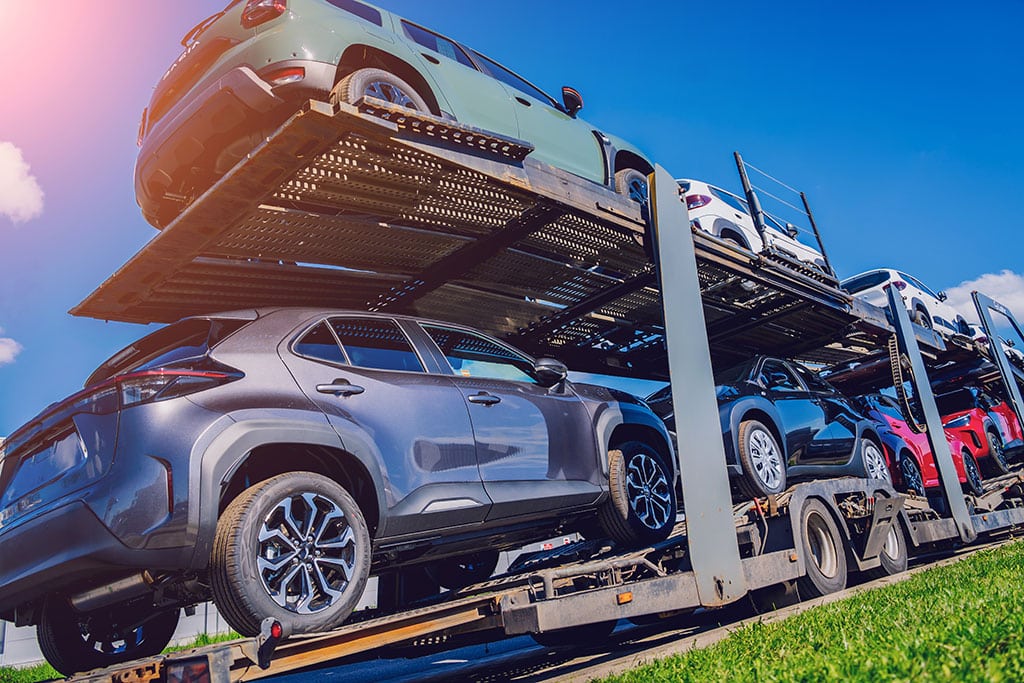The short answer is yes.
But it requires a bit more explanation. Here are the pros and cons of buying a car in Canada and moving it to the United States.
Vehicle Authorization and Documentation
CON: The process to determine if your vehicle meets specific requirements set forth by the EPA can be daunting.

The Clean Air Act prohibits the importation of any motor vehicle into the United States that does not conform to the EPA emission standards and requirements. These standards apply to all vehicles and engines, including imported motor vehicles, heavy-duty engines, nonroad engines (generators, watercraft, and lawn and garden equipment), and recreational vehicles, whether they are new or used, manufactured domestically or abroad.
The EPA primarily assesses if a vehicle: (1) is a U.S. version vehicle and (2) meets conformity with EPA and Department of Transportation (DOT) regulations.
So, what is a U.S. version vehicle? It’s a vehicle manufactured in conformity with U.S. federal emission requirements. You can tell by the label in the engine compartment that states the vehicle meets all EPA regulations.
Pro tip: A modified or altered vehicle may be conditionally imported as a U.S. version pending repair and restoration. For example, if the engine was altered or replaced with another type of engine, the vehicle is no longer considered a U.S. version. Upon entry, you must file an EPA Form 3520-1 with Customs, declare code “F” on the form and post a bond with Customs. The importer has 120 days to demonstrate to the EPA that the vehicle has been repaired or restored to its original configuration.
PRO: Many Canadian vehicles have emission control systems that are identical to the emission control systems on vehicles certified in the United States.
However, some Canadian vehicles may not have an emissions compliance label identifying them as such. All vehicles manufactured in conformity will have this label. If not, alternative proof is required.
You can get proof by getting a written statement from the manufacturer’s U.S. representative that says the vehicle is a U.S. version. What is NOT accepted as proof is:
- Passing a state inspection test as they do not determine conformity with federal emission standards
- The presence of a catalytic converter as it does not mean the vehicle is a U.S. version or that it meets federal emission standards
You can check on your vehicle by reviewing the Overview of EPA Import Requirements for Vehicles and Engines. You will likely need to know the following about your vehicle:
- Year of manufacture;
- Model year, make, and model of vehicle;
- Whether the vehicle conforms to U.S. emissions requirements;
- Type of fuel the vehicle uses;
- Whether the vehicle was manufactured with or without a catalytic converter; and
- Gross vehicle weight for trucks
CON: There’s SO much paperwork involved!
That’s true. There’s an entry form process with a lot of requirements; a special form for if you plan to return to Canada; more forms; official identification like a passport, driver’s license and birth certificate; more forms; and of course, proof of ownership of the vehicle. Here’s a list of the car shipping documents and the details.
- 3299 Entry Form. This form is required for all vehicles entering from Canada into the United States. 3299 Form requirements include:
- Make sure to print your name as it appears on your passport.
- Include your date of birth as well as the date you will arrive in the United States.
- Add your U.S. home address and contact phone number.
- No P.O. Boxes are accepted. If you don’t have a home address, leave this portion blank.
- For snowbirds: When you return to Canada, make sure to bring a copy of a completed Canada Border Services Agency (CBSA) Form E-24 Personal Exemption CBSA Declaration. This should list all the items being driven back in your car. You should also bring a copy of the completed Form E-15 when your vehicle initially entered the United States.
Pro tip: Keep the original copy of Form E-15 to present at airport Customs, which details items that will follow separately. - 7501 Entry Form. This is the form done at Customs that you’ll use for vehicles originating from Canada being brought across the U.S. border for over a year. These vehicles will be registered as U.S. vehicles for the duration of their stay. It’s important to note that you will not be allowed to register the car with the Department of Motor Vehicles until you receive the formal entry form. You will also file the 7501 Entry Form if:
- A car from the United States was transported to Canada and the U.S. title was given up during the transport process and will now be returning to the United States. The car will then have to be re-titled and re-registered within the United States.
- A vehicle titled in the United States has switched owners in Canada and the new owner of the car is transporting the car back to the United States with proof of the original U.S. title.
- E-15 Form. Complete a CBSA Form E-15 Certificate of Destruction/Exportation. This should be a complete and accurate list of all your personal items. If you fail to complete this form, you may have to pay duty and taxes on personal items if and when you return to Canada.
- HS-7 Form (this is required for all Canadian vehicles coming into the United States).
- Official identification. You will need a copy of your passport or a copy of your driver’s license and birth certificate.
- Proof of ownership. A copy of vehicle ownership.
Note that while this article is meant to be a helpful overview, laws can change at any time. You should always confirm these steps with the relevant agencies like US Customs & Border Patrol (CBP) and the Department of Transportation (DOT) OR give Reindeer a call and we can work through the current regulations.
PRO: If you decide to ship your vehicle, the experts at Reindeer can help with the process and the paperwork!
With a move from Canada to the United States, you could opt to transport the vehicle yourself. But one of the many benefits of hiring a specialist is that we guide you through the process, no matter how complicated.
Once you’ve chosen Reindeer for your shipping needs, we’ll connect you with a relocation coordinator to plan your move. Your relocation coordinator will be your contact person throughout the entire shipping process. Our relocation team has extensive experience arranging vehicle transportation from Canada to the United States, handling thousands of car shipments over the last 20 years.
To get a jump on the process, you may want to check out the following resources (and we’ll assist you as well):
- Canada’s Registrar of Imported Vehicles
- Canada Border Services Agency Registrar of Imported Vehicles
- Importing Canadian Vehicles – Emissions
- National Highway Traffic Safety Administration (U.S.)
- HS-7 Form (this is required for all Canadian vehicles coming into the United States)
Vehicle Purchase Price
PRO: Bringing your vehicles to the United States is currently cheaper than buying a new vehicle.

The key word there is currently. According to Driving.ca, the average price of a new car in Canada is around CAD $67,000, which equates to about $46,600 with the existing conversion rate. Compare that to the average price for a new vehicle in the United States, at $48,039 in February 2025, according to a report from Kelley Blue Book.
But keep in mind that this doesn’t factor in import duties. You will be required to pay import duties of some sort when moving your vehicle from Canada to the United States unless you’re a certain government official or representative. The duty rate for vehicles is usually 2.5% of the vehicle’s value but may vary depending on the vehicle type and trade agreements.
On the flip side, new vehicles in the United States have tariffs to worry about. A vehicle not manufactured in the United States is subject to the 25% tariff before it hits the dealership, and the dealership will pass that extra cost onto the consumer. For the same reason, the pre-owned market is increasing because the consumers don’t want to pay that premium.
CON: The tariffs on Canada that directly impact the auto industry will increase the price of cars significantly. When and how are unclear.
Unfortunately, prices will go up in Canada, Mexico and the U.S. because the countries all trade vehicle parts. No car is completely built in one country.
For example, according to University of Windsor automotive engineering professor Peter Frise, “Corvettes are made in Kentucky, but their gearboxes are made in St. Catharines, Ontario, and the aluminum for the engines comes from Quebec. North America and Europe have the same system, where parts move freely across borders, and the sourcing of parts changes all the time.”
And with the uncertainty of the tariffs, there’s no way to tell exactly how much or when the prices will increase. If the tariffs eventually take effect, car prices in the United States could rise by $2,000 to $12,200, depending on the model, according to a recent estimate from the Anderson Economic Group (AEG), a Michigan-based economic consultancy. But, if you already bought the car in Canada, good for you! Reindeer can help you move it.
Vehicle Shipping
Pro: Shipping your vehicle with an auto relocation company like Reindeer prevents wear and tear on your vehicle…and you.

If you’re moving from, say, Vancouver to New York City, that’s a LONG drive. It’s about 4,809 km (or 2,988 miles) and about 45 hours if you were to drive straight through. Not only will this take a toll on your vehicle, but it’ll also wear you out from all the driving. Shipping your vehicle keeps you from making a multi-day trip and saves you considerable time.
And if you’re a car buff with a high-end or collectible vehicle, you definitely don’t want to add nearly 3,000 miles to the odometer. Instead, you can ship it in an enclosed carrier and keep it protected from the elements and any road debris.
CON: Shipping your vehicle from Canada to the U.S. could be pricey.
Yes, there’s a cost to ship your car. But it also costs money to pay for the meals, lodging, and gas you’ll need during your road trip if you choose to drive it. And, as we mentioned before, it’s more affordable than the cost of purchasing a new vehicle once you get to the United States.
And while I’d love to give you an idea of cost, there are too many variables that factor into the shipping rate for your specific situation. These variables include:
- Vehicle type and size. Larger vehicles that take up more space – sometimes the space of two vehicles – will be more costly to ship.
- Location of pick-up & delivery. Like the Vancouver to New York City example above, that’s going to cost much more than Vancouver to San Francisco, for example, simply due to the number of miles. Additional factors like unpaved roads, steep driveways, or unusual site situations can also impact the time and costs of the shipment.
- Open vs. enclosed transportation. Open car shipping is more affordable than enclosed. Learn more about both options from our blog, Open vs enclosed car shipping: Pros and cons of each transport method.
- Time of year. Peak moving season – May through September – will be more costly than other times of the year.
- Vehicle condition. Car shipping rates may depend on whether or not your car is operable as it may need to be driven on and off the truck.
- Delivery timeline & preferences. If you’re on a tight deadline to get your car moved, it’s probably going to cost you.
Keep in mind that when bringing a vehicle to the United States from Canada, there may be additional fees or taxes associated with importing, but these also vary.
PRO: It makes your move easier and less stressful.
With a big move, especially one to a different country, it’s already going to be stressful enough. Between packing, hiring movers, and basically transferring your entire life to another country, the last thing you need to worry about is driving your car.
Driving your vehicle requires you to plan a route across multiple provinces and navigate various terrains, which can be extremely taxing. Not to mention that parts of your journey may include infuriating bumper-to-bumper traffic. Shipping your vehicle eliminates that stress and worry.
An auto transport specialist can help arrange and/or support you throughout the move, no matter what your needs might be. They will support you in the following matters:
- Choosing between open or enclosed vehicle carriers
- Handling logistics
- Door-to-door service
- Snowbird service
- Ensure you know where your car is at every step of the transport process, including arrival time
A bonus: Reindeer provides specialty relocation services for more than just cars. We can also move mobile homes, golf carts, RVs, trailers, houseboats, motorcycles, electric vehicles and more.
In summary
Each year, thousands of people move from Canada to the United States and vice versa, sometimes permanently and sometimes for part of the year. There are several pros and cons to buying a vehicle in Canada and moving it to the United States vs. waiting until you move. Every situation is unique, and you need to make sure you choose what works best for you.
If you’re considering moving from the Great White North, Reindeer can handle the transport. Contact us today to get started!
Privacy Overview
| Cookie | Duration | Description |
|---|---|---|
| cookielawinfo-checbox-analytics | 11 months | This cookie is set by GDPR Cookie Consent plugin. The cookie is used to store the user consent for the cookies in the category "Analytics". |
| cookielawinfo-checbox-functional | 11 months | The cookie is set by GDPR cookie consent to record the user consent for the cookies in the category "Functional". |
| cookielawinfo-checbox-others | 11 months | This cookie is set by GDPR Cookie Consent plugin. The cookie is used to store the user consent for the cookies in the category "Other. |
| cookielawinfo-checkbox-necessary | 11 months | This cookie is set by GDPR Cookie Consent plugin. The cookies is used to store the user consent for the cookies in the category "Necessary". |
| cookielawinfo-checkbox-performance | 11 months | This cookie is set by GDPR Cookie Consent plugin. The cookie is used to store the user consent for the cookies in the category "Performance". |
| viewed_cookie_policy | 11 months | The cookie is set by the GDPR Cookie Consent plugin and is used to store whether or not user has consented to the use of cookies. It does not store any personal data. |